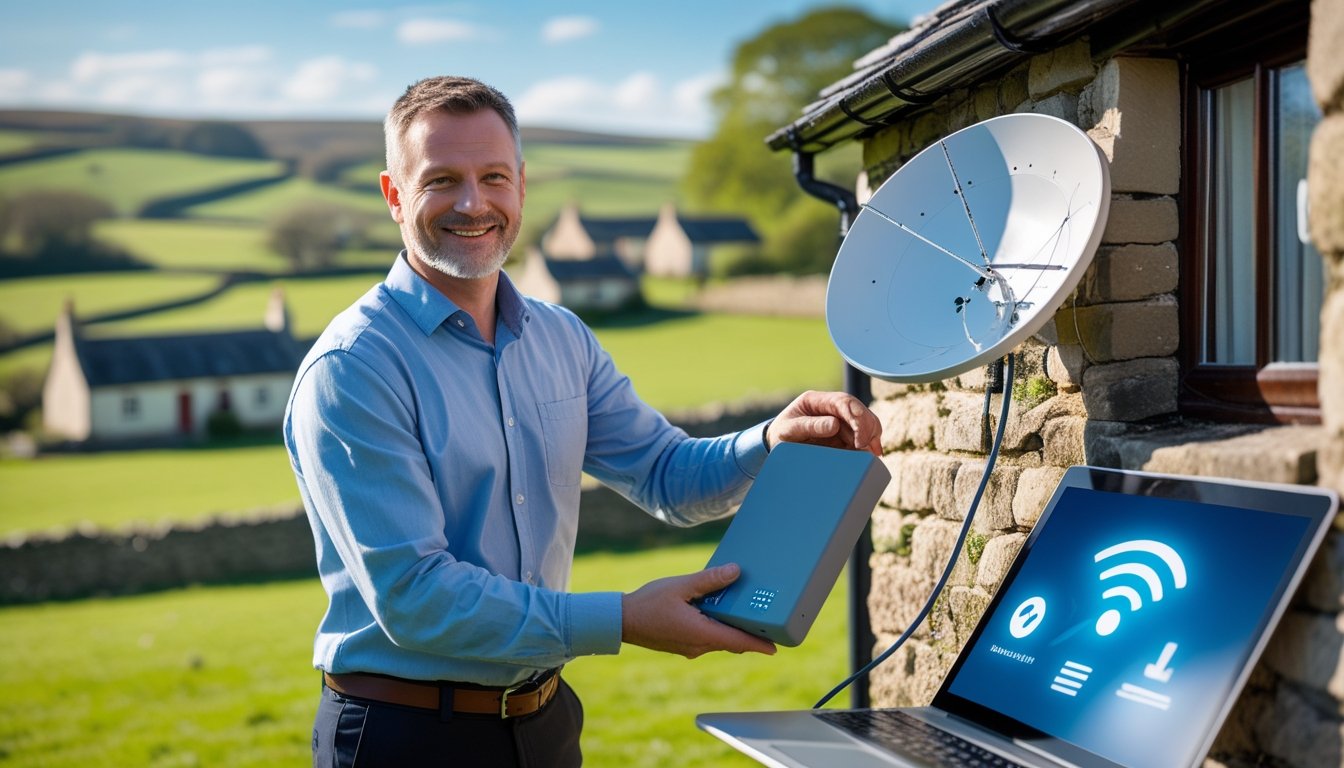Late updated: 27 Jul 2025 12:07
Written by: Oliver Bennett
Innovative Broadband Solutions for UK Countryside Residents: Bridging the Connectivity Gap
In the vast UK countryside, accessing reliable, high-speed broadband has been a challenge for many residents. This digital divide has placed rural communities at a disadvantage, impacting everything from education to business operations. We're here to explore how innovative solutions are transforming broadband availability for countryside residents, enabling them to enjoy connectivity that rivals urban areas.

With advancements in technology such as fibre-optic networks, 5G, and satellite broadband, these once-elusive services are becoming more accessible. Rural-specific providers and government initiatives are at the forefront of these upgrades, bringing next-generation solutions to even the most remote areas. From ultrafast fibre to innovative wireless systems, the future of rural connectivity looks bright.
Key Takeaways
- Innovative tech bridges the digital divide for rural UK.
- Fibre, 5G, and satellite enhance countryside connectivity.
- Future looks promising for rural broadband.
Key Challenges And Opportunities For Rural Broadband In The UK

In the UK countryside, significant challenges persist in delivering reliable, high-speed broadband. Various initiatives are in place to bridge these gaps, offering potential opportunities for enhanced connectivity in rural regions.
Connectivity Issues And Limited Broadband Options
Limited infrastructure in rural regions creates significant barriers to broadband access. Many countryside areas suffer from low-density populations, which often make it economically challenging for service providers to invest in infrastructure development. The lack of sufficient cable networks further limits the available broadband options. As a result, residents face a trade-off between choosing costly satellite services or managing with subpar DSL connections.
Community-driven solutions have started to emerge, encouraging local collaborations and involving local authorities and volunteers to deploy fibre networks. These efforts aim to provide more competitive options and cater to the specific connectivity needs of rural populations. Despite these initiatives, limited broadband options remain a key challenge to overcoming the digital divide in the UK countryside.
Coverage Gaps In The Countryside
Coverage gaps in the countryside are a significant issue, leaving some regions disconnected from high-speed internet services. Given the geographical complexities of the UK countryside, deploying fibre optic cables is often more challenging and costly. As a result, vast areas remain underserved, stalling digital development.
The Shared Rural Network and initiatives like Project Gigabit are working to improve this by expanding 4G and 5G coverage, ensuring that mobile broadband can serve as a viable substitute in areas where fibre deployment is not feasible. This approach is essential to ensure that all regions, regardless of geography, have access to essential communication services. Bridging these gaps is vital for fostering economic growth and social inclusion in rural areas.
Importance Of Reliable And Fast Internet
The importance of reliable and fast internet for UK countryside residents cannot be overstated. It provides opportunities for remote education, telehealth, and allows local businesses to compete more effectively on a national scale. High-speed broadband facilitates access to digital resources and services, which are crucial for improving quality of life.
The disparity in broadband speeds between urban and rural areas affects productivity and innovation in the countryside. As more services move online, reliable internet becomes essential for daily activities. Addressing these needs involves not only improving infrastructure but also ensuring households and businesses understand and utilise the available technology efficiently. As we continue to advocate for robust solutions, the focus remains on ensuring reliable and fast internet reaches all rural residents in the UK.
Innovative Solutions For Countryside Connectivity
Achieving reliable internet connectivity in the UK countryside requires diverse solutions due to varying geographical and infrastructural challenges. We're exploring major options such as full fibre broadband, mobile networks, and satellite services, along with government initiatives, to enhance rural connectivity.
Full Fibre Broadband And Fibre To The Premises (FTTP)
Fibre broadband, particularly Fibre to the Premises (FTTP), offers gigabit-capable internet by delivering fibre-optic cables directly to homes. This infrastructure supports seamless high-speed connections essential for modern digital activities, including streaming and remote work. Projects funded by Gigabit Broadband Voucher schemes help rural residents access these services, offsetting installation costs. Collaboration with internet service providers ensures these cutting-edge technologies become available even in the most remote areas, significantly reducing the digital divide.
4G, 5G And Mobile Broadband Options
Mobile broadband solutions, including 4G and the emerging 5G networks, bring flexibility to rural connectivity. These options eliminate the need for extensive cabling and infrastructure, making them ideal for sparsely populated areas. 5G technology promises increased speeds and reduced latency, transforming mobile broadband into a viable alternative for fixed connections. Providers offering unlimited data plans provide further appeal, enabling rural users to access fast internet without worrying about data caps. By establishing multiple masts and enhancing coverage, these networks can effectively reach underserved areas.
Satellite Broadband For Remote Areas
For the most isolated locations, satellite broadband becomes a lifeline. Using satellites orbiting the Earth, providers offer high-speed internet access where terrestrial infrastructure falls short. Recent innovations have improved speeds and reliability, making satellite connections more competitive. Services like Starlink exemplify advancements with low-orbit satellites, reducing latency compared to traditional satellite internet. While there might be higher initial equipment costs, the potential for broad coverage makes this an attractive solution for rural residents who face connectivity challenges.
Government Initiatives And Broadband Voucher Schemes
Government-backed initiatives play a crucial role in bridging the digital divide in rural areas. The Project Gigabit aims to deliver gigabit-capable connections to hard-to-reach premises, significantly enhancing the existing infrastructure. Broadband voucher schemes provide financial assistance to residents and small businesses, encouraging the adoption of innovative broadband solutions. These initiatives foster collaboration between local governments and service providers, ensuring resources are directed to areas most in need. By supporting infrastructure development and improving access to technologies, these government programmes contribute to sustainable rural connectivity.
Frequently Asked Questions

As we explore innovative broadband solutions for countryside residents, several questions frequently arise. These range from government plans and technological advancements to funding options and application procedures for improving rural broadband infrastructure.
What funding options are available to support the deployment of broadband in rural communities?
There are various funding avenues currently available for enhancing broadband in rural areas. Government grants and community-led investments play a significant role. Additionally, private sector partnerships often provide financial backing to address connectivity challenges faced by countryside residents.
How does the government plan to ensure high-speed internet access in remote areas?
The UK government has committed to expanding broadband access to remote regions through targeted infrastructure projects. Initiatives to provide gigabit-capable internet connectivity by 2030 are underway. Plans involve collaborations with local authorities and private enterprises to ensure effective rollout.
What initiatives are currently in place for enhancing broadband connectivity for UK countryside dwellers?
Several ongoing initiatives focus on bridging the digital divide in rural locales. Programmes like Openreach's fibre expansion and community-driven projects aim to deliver high-speed internet. Efforts also include improving existing technologies and introducing new solutions tailored to the specific needs of remote communities.
What advancements have been made in broadband technology to address the connectivity issues in sparsely populated areas?
Recent advancements include the deployment of satellite internet and fixed wireless access, which overcome traditional infrastructure limitations. The use of 5G technology also provides a cost-effective alternative to fibre, making high-speed internet more accessible than before in sparsely populated regions.
When is the expected completion date for the rural broadband expansion projects?
The expected timeline for the completion of rural broadband expansion projects varies. Many major initiatives are projected to be completed by 2030, aligning with the goal to offer gigabit-capable internet to 99% of UK residents. Some projects may be completed sooner, depending on local conditions and funding availability.
How can residents in rural localities apply for grants or subsidies to improve their broadband infrastructure?
Residents can inquire about local grant opportunities through their community councils or local authority websites. Detailed procedures and application forms are typically available online. It's advisable to stay informed about eligibility criteria and deadlines to ensure successful grant application submissions.
